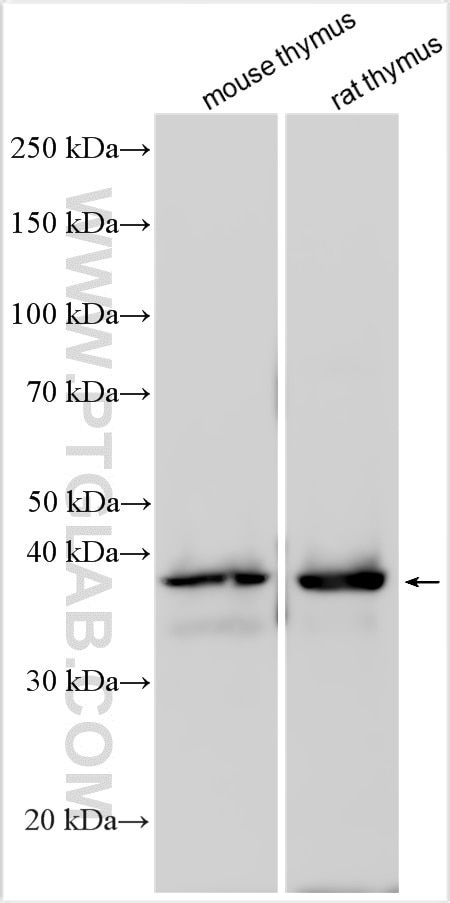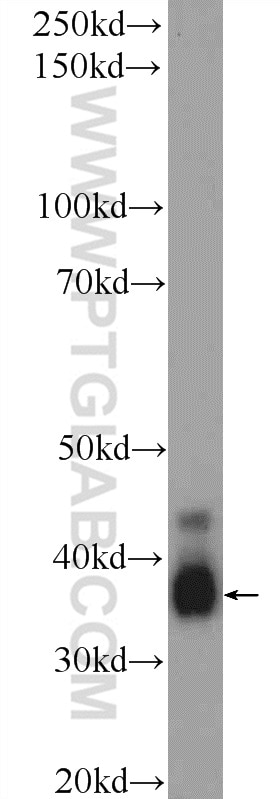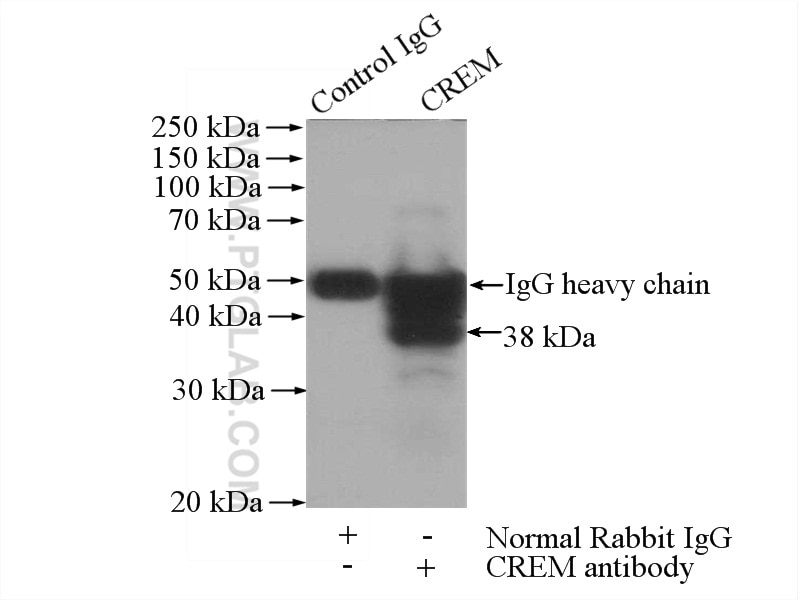Anticorps Polyclonal de lapin anti-CREM
CREM Polyclonal Antibody for WB, IHC, IP, ELISA
Hôte / Isotype
Lapin / IgG
Réactivité testée
Humain, rat, souris
Applications
WB, IHC, IF, IP, ELISA
Conjugaison
Non conjugué
N° de cat : 12131-1-AP
Synonymes
Galerie de données de validation
Applications testées
| Résultats positifs en WB | tissu testiculaire de rat, tissu de thymus de rat, tissu de thymus de souris |
| Résultats positifs en IP | tissu testiculaire de souris |
| Résultats positifs en IHC | tissu de cancer de la prostate humain, il est suggéré de démasquer l'antigène avec un tampon de TE buffer pH 9.0; (*) À défaut, 'le démasquage de l'antigène peut être 'effectué avec un tampon citrate pH 6,0. |
Dilution recommandée
| Application | Dilution |
|---|---|
| Western Blot (WB) | WB : 1:200-1:1000 |
| Immunoprécipitation (IP) | IP : 0.5-4.0 ug for 1.0-3.0 mg of total protein lysate |
| Immunohistochimie (IHC) | IHC : 1:400-1:1600 |
| It is recommended that this reagent should be titrated in each testing system to obtain optimal results. | |
| Sample-dependent, check data in validation data gallery | |
Applications publiées
| WB | See 2 publications below |
| IHC | See 1 publications below |
| IF | See 5 publications below |
Informations sur le produit
12131-1-AP cible CREM dans les applications de WB, IHC, IF, IP, ELISA et montre une réactivité avec des échantillons Humain, rat, souris
| Réactivité | Humain, rat, souris |
| Réactivité citée | Humain, souris |
| Hôte / Isotype | Lapin / IgG |
| Clonalité | Polyclonal |
| Type | Anticorps |
| Immunogène | CREM Protéine recombinante Ag2775 |
| Nom complet | cAMP responsive element modulator |
| Masse moléculaire calculée | 332 aa, 36 kDa |
| Poids moléculaire observé | 36 kDa |
| Numéro d’acquisition GenBank | BC017117 |
| Symbole du gène | CREM |
| Identification du gène (NCBI) | 1390 |
| Conjugaison | Non conjugué |
| Forme | Liquide |
| Méthode de purification | Purification par affinité contre l'antigène |
| Tampon de stockage | PBS with 0.02% sodium azide and 50% glycerol |
| Conditions de stockage | Stocker à -20°C. Stable pendant un an après l'expédition. L'aliquotage n'est pas nécessaire pour le stockage à -20oC Les 20ul contiennent 0,1% de BSA. |
Informations générales
Cyclic AMP-responsive element modulator (CREM) is a transcription factor highly expressed in the post-meiotic germ cells of the testis. Its pivotal role is to regulate the expression of several germ cell-specific genes, a crucial function as demonstrated by the severe phenotype of mice whose CREM gene was mutated by homologous recombination. CREM-deficient male animals are sterile and display a ten-fold increase in the apoptosis of germ cells. Recent results have shown that CREM needs a tissue-specific co-activator, ACT (activator of CREM in testis) to elicit its regulatory function in testis (PMID: 10824972). Also, CREM is a crucial regulator of NK cell function. CREM exerts its regulatory functions through epigenetic reprogramming of CAR-NK cells (PMID: 40468083).
Protocole
| Product Specific Protocols | |
|---|---|
| WB protocol for CREM antibody 12131-1-AP | Download protocol |
| IHC protocol for CREM antibody 12131-1-AP | Download protocol |
| IP protocol for CREM antibody 12131-1-AP | Download protocol |
| Standard Protocols | |
|---|---|
| Click here to view our Standard Protocols |
Publications
| Species | Application | Title |
|---|---|---|
Biofabrication Testis on a chip - a microfluidic 3-dimensional culture system for the development of spermatogenesisin-vitro. | ||
Int J Mol Sci Effect of Chemotherapy Cytarabine and Acute Myeloid Leukemia on the Development of Spermatogenesis at the Adult Age of Immature Treated Mice. | ||
Int J Mol Sci The Expression Levels and Cellular Localization of Pigment Epithelium Derived Factor (PEDF) in Mouse Testis: Its Possible Involvement in the Differentiation of Spermatogonial Cells. | ||
Int J Mol Sci Effect of Temperature on the Development of Stages of Spermatogenesis and the Functionality of Sertoli Cells In Vitro | ||
Life Sci Adrenocorticotropic hormone and its receptor as a novel testicular system involves in the development of spermatogenesis |






